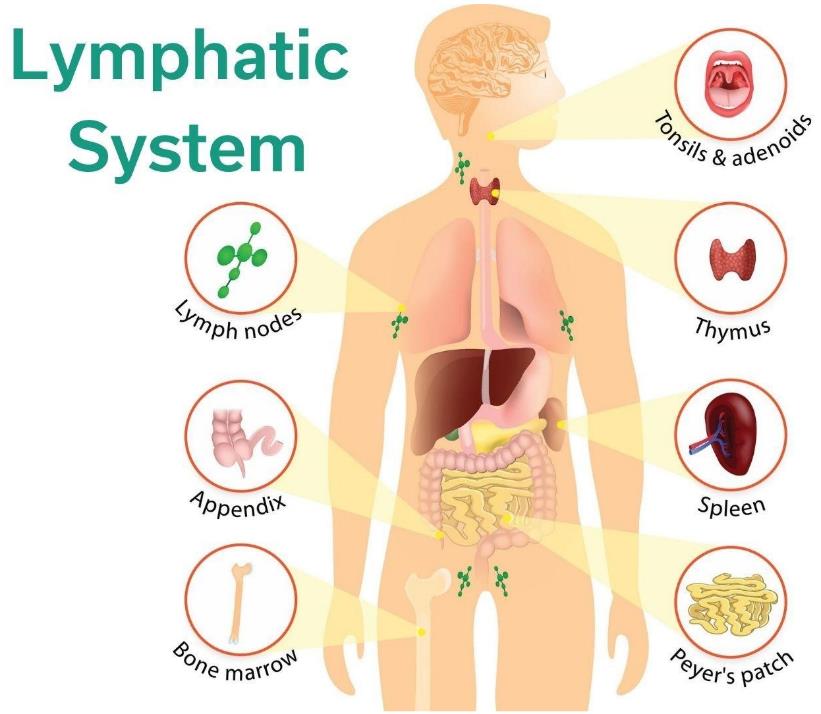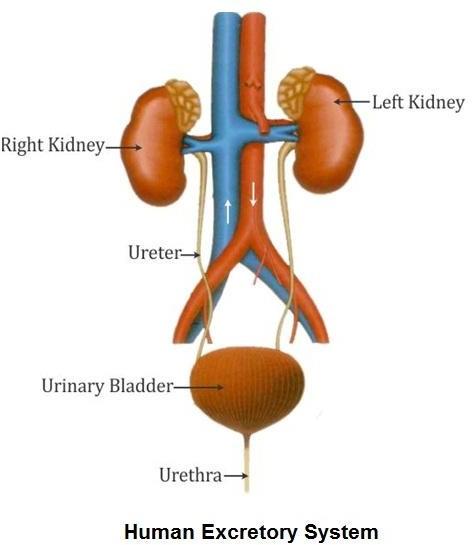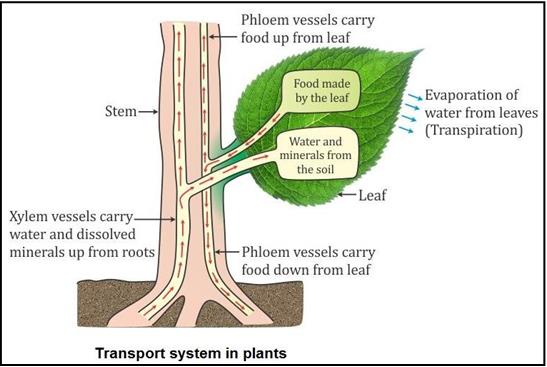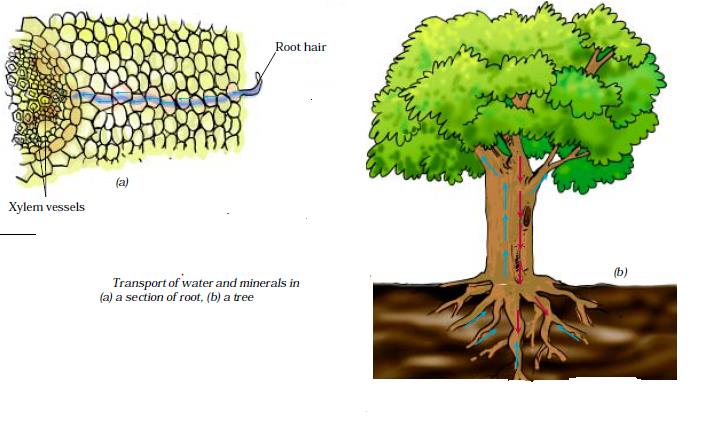Transportation in Animals and Plants
Circulatory System
- The circulatory system is defined as the system which moves blood, oxygen and nutrients through the body.
- An example of the circulatory system is the functioning of the human heart, blood and blood vessels.
Blood
- Blood is a fluid which flows in blood vessels and transports substances such as digested food from the small intestine to other parts of the body.
- It carries oxygen from the lungs to the other cells of the body.
- It transports waste for removal from the body.
- Blood is a liquid containing many kinds of cells suspended in it. The fluid part of the blood is called plasma.

- Blood carrying oxygen is called oxygenated blood and the blood lacking oxygen is called deoxygenated blood.
- Animals such as Hydra and sponge lack a circulatory system. The water in which they live carries food and oxygen when it enters the body. The waste materials and carbon dioxide are carried away with water when it moves out.
- Unicellular animals such as Amoeba and Paramoecium living in water also have no blood in them.
Blood Vessels
- Arteries carry oxygen-rich blood from the heart to all parts of the body. The walls of the arteries are thick and elastic because the blood flow is rapid and at high pressure.
- Capillaries are present throughout the body. The exchange of substances (Examples – food, oxygen and carbon dioxide) between the blood and the body cells occurs through capillaries.
- Veins carry carbon dioxide-rich blood from all parts of the body back to the heart. They have thin walls.
- The number of pulse beats per minute is known as the pulse rate. The pulse rate is the same as the heart rate.
Heart
- The heart is a fist-sized muscular organ found in the chest cavity towards the left lungs. It pumps blood to all parts of the body. It beats 60-80 times a minute throughout our life.
- The heart is made up of four chambers. The Upper two chambers are called right atrium and left atrium. The two lower chambers are called right ventricle and left ventricle.
- A muscular wall called septum separates the right and left side of the heart, preventing the mixing of oxygenated blood with the deoxygenated blood and have valves. Valves allow the blood to flow in only one direction.
- The blood rich in carbon dioxide flows through the right side of the heart, while the blood rich in oxygen flows through the left side of the heart.

The arteries and veins in the heart connect to other parts of the body. The blood vessels that enter or leave the heart are:
Vena cava: It is a large vein that collect blood rich in carbon dioxide from all parts of the body through smaller veins and empties the blood from the right atrium.
Pulmonary artery: It carries blood rich in carbon dioxide from the right ventricle of the heart to the lungs.
Pulmonary vein: It brings oxygenated blood from the lungs to the left atrium of the heart.
Aorta: It is the largest artery which receives blood rich in oxygen from the left ventricle. The oxygenated blood is then circulated to different parts of the body.
Working of heart:
- The heart functions as a double pump. Impure (deoxygenated) blood from the veins flows into the right Atrium of the heart.
- From here, the blood enters the right ventricle through an opening.
- The impure blood is transported from the right ventricle to the lungs by the Pulmonary artery.
- Gaseous exchange takes place in the lungs.
- The blood gives off carbon dioxide and takes in oxygen.
- Oxygen-rich blood is carried to the left Atrium by the Pulmonary vein.
- From here, the blood flows through an opening into the left ventricle.
- The left ventricle pumps oxygen rich blood to every part of the body through the aorta.
- The oxygen is then used by the cells and the cell produces carbon dioxide.
- The blood takes in carbon dioxide and returns to the right ventricle of the heart.
Heartbeat
- The walls of the chambers of the heart are made of muscles which contract and relax rhythmically. This rhythmic contraction and relaxation of muscles constitute a heartbeat.
- The rhythmic beating of the heart maintains the circulation of blood and the transport of substances to different parts of the body.
- The average heartbeat of an adult person while resting is 72 to 80 per minute. It increases during and after physical exercise.
- The heartbeat can be heard by using an instrument called a stethoscope. It amplifies the sound of a heartbeat.
Lymphatic system of the human body
- The lymphatic system is made up of lymph vessels and lymph nodes.
- As the blood flows through the capillary some of the plasma oozes out of the walls. Most of the fluid enters the lymph vessels and is drained back into the blood vessels.
- Before this blood is returned to the circulatory system, it is filtered through lymph nodes. lymph nodes contain special types of cells called Lymphocytes which protect the human body from disease causing organisms and harmful substances.

Excretion
- When cells perform their functions, certain waste products which are toxic in nature need to be removed. The process of removal of wastes is called excretion.
Excretory System in Humans
- The different parts of the human excretory system are two kidneys, two ureters, urinary bladder and urethra.

- Of the useful and harmful substances in the blood which reach the kidneys, the useful substances are reabsorbed into the blood. The wastes dissolved in water are removed as urine.
- From the kidneys, the urine goes into the urinary bladder through tube-like ureters.
- The bladder stores urine till the time it is passed out through the urinary opening at the end of a muscular tube called urethra.
- An adult human being passes about 1-1.8 litres of urine which consists of 95% water, 2.5% urea and 2.5% waste products.
- Sweat is also a type of excretory product containing water and salts. It is removed from the body by sweat glands through the skin.
Excretion in Animals
- Aquatic animals excrete cell waste in gaseous form (ammonia) which directly dissolves in water.
- Birds and land animals such as lizards, snakes and insects excrete a white-coloured semi-solid waste called uric acid.
Excretion in plants
- Plants excrete waste products from their body. They get rid of their waste product in the following ways:
- Oxygen and Carbon dioxide are given out during the process of photosynthesis and respiration.
- The excess water is lost by the plants through transpiration.
- Some plants excrete their waste product in the form of gums, resins and latex. The substances are of great use as adhesive, paints, varnishes and rubber.
Transport of Substances in Plants
- Plants absorb water and minerals from the soil through roots and transport these to leaves, where food is prepared.
- Since food is a source of energy, it must be made available to every cell of the organism. To serve this purpose, a transport system is present in plants.
Transport of Water and Minerals
- Plants have pipe-like vessels to transport water and nutrients from the soil. These vessels are made of special cells forming a vascular tissue.
- The vascular tissue for the transport of water and nutrients in plants is called xylem, while that for the transport of food is called phloem.


Transpiration
- When plants absorb mineral nutrients and water from the soil, some of it is absorbed by the plant while some evaporates through the stomata present on the surface of the leaves by the process of transpiration.
- This evaporation of water from leaves causes a suction pull which is able to pull water to great heights in tall trees.
- Just like sweating helps to keep our body cool, transpiration cools the plants.
